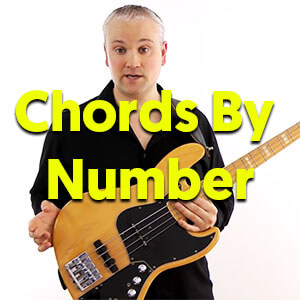

When a musician reads the number chart, they determine the chords by counting the scale tones up from note 1, and playing the chord that corresponds to the resulting letter. The numbers we use in the Nashville Number System come from the position of a note in the scale sequence: in the key of C, C is 1, D is 2, E is 3, and so on. Understanding this puts the math in a whole new light. This sense of resolution – of a return to home, to stability – is the essence of how our musical system works, and the most important conceptual meaning of the term “key” or “key center”. The difference between the two examples is one note, but it makes all the difference! Notice how the final C note in the second example creates a sense of completion that was missing from the first one. You’ll probably notice that the last note sounds unresolved, that the musical idea feels incomplete. Use the tab if you don’t know the note locations: To illustrate this point, play the following 7 notes. Once this is established in your ear, you will perceive (consciously or unconsciously) that the patterns in the music will generally lead you “home” at the end of the song or sequence. The particular pattern of the notes creates a “key center”: a musical home base that determines how you hear the relationships between notes. That means that there are certain notes that are most likely to be used, and others that are likely to be omitted. The basic concept to understand is that a song is generally said to be “in a key”. With a little knowledge you can use the concepts behind the NNS to learn a song by ear, figure out a capo position to play in, or transpose a song to a new key. It’s a great example of the practical use of music theory. But this book is a fascinating and fun read, particularly the various and varied actual handwritten pages of Nashville notation made by experienced musicians.The Nashville Number System is a method of musical shorthand devised in the late 1950’s by Bill Matthews of the Jordanaires (most famous as the vocal quartet backing Elvis on his early recordings). I'm not at all sure that it really wouldn't be just as easy to become good at reading standard music notation as reading Nashville. They just use different symbols for the same things-like a diamond for whole note, for example. It's a bit funny, though, because it ends up being almost as complicated as learning standard music notation, if you go the whole way. I found this book fascinating, particularly as to the lengths to which Nashville-using musicians have each gone to flesh out the Nashville number system. When a jazz musician says "IV chord," he's saying exactly what a Nashville player says when he says "4 chord." It's just that they got there by different routes. I once saw a jazz pianist coach his bassist through a live performance of an old jazz standard that the young bassist didn't know by simply flashing fingers at each chord change-and there were more than just three chords in that tune. I bought this book because I wanted to find out what the Nashville number system was all about and how it differed from the numbers that jazz musicians commonly refer to-usually in Roman numerals. Transposition is expected daily" - "What did you call me?!" - *facepalm* We're so smart." - "Dude, um, we've been doing that in Jazz for like 80 years now" - "Nuh, uh" - "Umm, seriously, we learn all songs in 12 keys. Don't know it? *scoff* You take a chord, and then turn it into a number!!! Then you can use that number in any key you like.


"We use this advanced music tool called the Nashville Number System. Why is Country music stuck 60 years behind everyone else? And why do they perpetually claim to make inventions of things that were invented 60 years before they "discovered" it. And I won't even rant about adding a 7th to any of those, we'll leave that for another day. Maybe even a number for a secondary dominant, say a major VI chord instead of a minor vi chord. I mean, please tell me there's at least some number to change the key of the bridge or modulate up a half step in the 3rd chorus. There has to be something more, to give it such a grandiose name as "The Nashville Number System". Can somebody please tell me it's more than just: I chord, ii chord, iii chord, etc. This may be a slight continuation of another CL rant thread, but I think there's some merit, so starting a new thread.


 0 kommentar(er)
0 kommentar(er)
